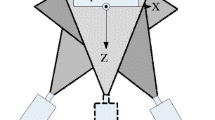Abstract
Assessing the metrological performance of the methods available for displacement field measurement is of primary importance in experimental mechanics. It often relies on synthetically rendered images of a specimen before and after deformation. In this context, the only varying quantity should be the displacement field in order to prevent any other phenomenon to bias the estimation of the metrological performance. Concerning digital image correlation (DIC), images of a random speckle pattern are needed. We propose a new algorithm to render such images with a classic model of stochastic geometry, namely the Boolean model.
Access provided by Autonomous University of Puebla. Download conference paper PDF
Similar content being viewed by others
Keywords
8.1 Introduction
The most popular methods for estimating the displacement field on the surface of a specimen subjected to a mechanical load are certainly the ones based on digital image correlation (DIC) applied on speckle images acquired before and after deformation. A crucial question, which numerous papers aim at addressing (see for instance [1]) is the characterization of the metrological performance of these methods. Using synthetically rendered speckle images allows comparing the estimated displacement field with the ground truth used for data generation. However, the resolution of the displacement field returned by any DIC software program is affected by both the DIC program itself and the method used for rendering synthetic data. We propose a new rendering algorithm which mimics the acquisition of an image with a digital sensor, from physical deformation of the specimen to smoothing caused by the lens point spread function (PSF), spatial discretization, and gray-level quantization. In particular, it does not require any interpolation scheme likely to bias the accuracy estimation, as discussed in [1]. The aim is to complement datasets as those given in [2] which are provided by software programs such as TexGen [3]. Datasets and Matlab codes are freely provided to the community [4], and more details are available in a companion paper [5].
8.2 Rendering Speckle Images
The proposed algorithm is based on the Boolean model, a classic model of stochastic geometry having applications ranging from material analysis [6] to film grain modeling [7]. In the Boolean model, a random set P is defined as the union of a set of N random disks Di:
where the Di’s have random radii. These disks are spatially distributed following a Poisson point process. This approach models the formation of real speckle patterns in the sense that the surface of a tested specimen is often prepared by spraying ink, the disks representing randomly distributed ink droplets.
An infinite-resolution image \({\mathcal {I}}_0\) of the reference state is obtained by considering the indicator function of the random set P, which takes value 1 at ξ on the surface under investigation if ξ ∈P, and 0 otherwise.
A ground truth deformation map ϕ being given, an infinite-resolution deformed image is given by:
A gray-level digital image is eventually rendered by quantizing over b bits (typically, b = 8 or 12 bits), at any discrete pixel x, the value of the following integral:
where \(\widetilde {\mathcal {I}_0}(\boldsymbol {\xi })=\mathcal {I}_0(\boldsymbol {\xi })\) (reference image) or \(\widetilde {\mathcal {I}_0}(\boldsymbol {\xi })=\mathcal {I}_0^{\prime }(\boldsymbol {\xi })=\mathcal {I}_0 (\boldsymbol {\phi }(\boldsymbol {\xi }))\) (deformed image), 0 < γ ≤ 1 is the contrast, and Gσ is the PSF of the optical device (here, an isotropic Gaussian function of variance σ2, with σ ≃ 1 pixel).
Since no-closed form solution of this integral is available, we make use of Monte Carlo integration. We have proved in [5] that, if the size NMC of the Monte Carlo sample satisfies:
then α is an upper bound of the quantization error probability in the rendered image (a finer bound is actually available in [5]). This proves that the proposed algorithm gives an exact gray-level value at any pixel, except for a proportion α of them. A typical value is α = 5%. In practice, the quantization error is always less than one gray value at these pixels. Such an error is well below the noise floor of any digital sensor.
8.3 Results
The interested reader is kindly referred to [5] for additional information on calculation time, computational speed-ups, rounding errors caused by floating point arithmetic, and a discussion of aliasing. Figure 8.1 shows typical speckle images rendered by the proposed algorithm.
Top: Speckle images rendered with the proposed algorithm. Bottom, from left to right: inverse displacement field (here, the “punch” function of [3]), reference (non-deformed), and deformed speckle images. A non-realistic displacement field of large amplitude is deliberately used here to facilitate the visualization of both rendered images
References
Bornert, M., Doumalin, P., Dupré, J.C., Poilâne, C., Robert, L., Toussaint, E., Wattrisse, B.: Shortcut in DIC error assessment induced by image interpolation used for subpixel shifting. Opt. Lasers Eng. 91, 124–133 (2017)
Society for Experimental Mechanics: DIC challenge. http://sem.org/dic-challenge/
Orteu, J.J., Garcia, D., Robert, L., Bugarin, F.: A speckle texture image generator. Proc. SPIE 6341, 63410H (2006)
BSpeckleRender: (2018). https://members.loria.fr/FSur/software/BSpeckleRender/
Sur, F., Blaysat, B., Grédiac, M.: Rendering deformed speckle images with a Boolean model. J. Math. Imaging Vis. 60, 634–650 (2018)
Serra, J.: The Boolean model and random sets. Comput. Graphics Image Process. 12(2), 99–126 (1980)
Newson, A., Delon, J., Galerne, B.: A stochastic film grain model for resolution-independent rendering. Comput. Graphics Forum 36(8), 684–699 (2017)
Author information
Authors and Affiliations
Corresponding author
Editor information
Editors and Affiliations
Rights and permissions
Copyright information
© 2019 The Society for Experimental Mechanics, Inc.
About this paper
Cite this paper
Sur, F., Blaysat, B., Grédiac, M. (2019). Speckle Image Rendering for DIC Performance Assessment. In: Lamberti, L., Lin, MT., Furlong, C., Sciammarella, C., Reu, P., Sutton, M. (eds) Advancement of Optical Methods & Digital Image Correlation in Experimental Mechanics, Volume 3. Conference Proceedings of the Society for Experimental Mechanics Series. Springer, Cham. https://doi.org/10.1007/978-3-319-97481-1_8
Download citation
DOI: https://doi.org/10.1007/978-3-319-97481-1_8
Published:
Publisher Name: Springer, Cham
Print ISBN: 978-3-319-97480-4
Online ISBN: 978-3-319-97481-1
eBook Packages: EngineeringEngineering (R0)





